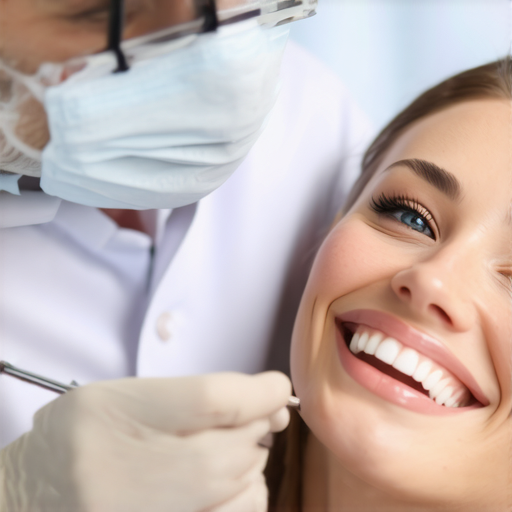Redefining Family Dentistry in 2024: Embracing Advanced Cosmetic Solutions
In the rapidly evolving landscape of dental care, the integration of cutting-edge cosmetic procedures into family dentistry paradigms signifies a profound shift towards holistic oral health and aesthetic excellence. As a seasoned expert in the field, I observe that the convergence of veneers, whitening, and Invisalign—particularly in the context of comprehensive family dental practices—necessitates a nuanced understanding of both technological advancements and patient-centered care strategies.
How Do Modern Veneers Elevate Aesthetic Restorations in Family Dentistry?
Contemporary veneers, especially from trusted providers like veneers made simple in 2025, exemplify the synthesis of cosmetic artistry and durable material science. These ultra-thin restorations, crafted with porcelain or composite resins, offer an optimal solution for correcting diverse aesthetic concerns—from microfractures to severe discoloration—while seamlessly integrating into family dental routines. Their minimally invasive nature ensures preservation of natural tooth structure, aligning with evidence-based minimally invasive dentistry principles.
What Are the Latest Innovations in Teeth Whitening for Family Members?
Teeth whitening remains a cornerstone of aesthetic dentistry, with innovations such as laser-assisted bleaching and custom whitening trays pushing the boundaries of efficacy and safety. The latest protocols, detailed in resources like effective teeth whitening strategies for 2024, emphasize tailored treatment plans that address individual staining patterns and enamel sensitivities. These advancements facilitate quick, predictable results suitable for all age groups within a family, fostering lifelong smile confidence.
Invisalign and Orthodontic Versatility: Beyond Teenagers
Invisalign, once perceived predominantly as a teenage orthodontic solution, now offers a versatile, discreet alternative for adults and multi-generational family applications. As outlined in Invisalign innovations in 2025, the system’s technological enhancements—such as SmartTrack material and digital planning—enable precise, predictable movements that harmonize with complex family dental needs. This evolution underscores the importance of integrating orthodontic options into comprehensive family care plans, ensuring aesthetic and functional harmony across generations.
What Are the Key Considerations When Combining Veneers, Whitening, and Invisalign in Family Dentistry?
Incorporating multiple cosmetic modalities requires meticulous treatment planning, considering factors like occlusion, enamel health, and long-term stability. A collaborative approach involving both general dentists and specialists ensures optimal outcomes. Moreover, patient education on maintenance routines—such as proper oral hygiene and regular check-ups—is crucial for preserving the integrity of these advanced treatments.
For a deeper exploration of integrated smile makeovers, consult authoritative sources like the American Academy of Cosmetic Dentistry. Additionally, practitioners are encouraged to contribute insights via professional forums and continuing education to refine best practices.
Enhance your practice’s offerings by exploring comprehensive guides such as trustworthy smile solutions in 2024 and stay at the forefront of aesthetic family dentistry innovation.
Unlocking the Synergy of Cosmetic Dental Solutions in Family Dentistry
As the landscape of family dental care continues to evolve, integrating advanced cosmetic treatments like veneers, teeth whitening, and Invisalign not only elevates aesthetic outcomes but also enhances overall oral health. The key to success lies in understanding how these modalities complement each other and the strategic planning needed to maximize results across generations.
Can a Holistic Approach to Cosmetic Dentistry Transform Multi-Generational Smiles?
Yes, adopting a holistic approach that considers the unique needs of each family member can lead to remarkable transformations. For instance, combining trustworthy veneers with personalized whitening protocols and discreet orthodontics creates a comprehensive smile makeover tailored to individual preferences and functional requirements. This strategy ensures that aesthetic enhancements do not compromise oral health, aligning with the principles outlined by the American Academy of Cosmetic Dentistry, which emphasizes the importance of minimally invasive and biocompatible treatments for long-term stability (AACD, 2022).
What Are the Practical Frameworks for Combining Cosmetic Modalities in Family Practice?
Implementing successful multi-modal cosmetic treatments requires a structured framework that incorporates comprehensive diagnostics, patient-specific treatment plans, and interdisciplinary collaboration. Digital smile design tools, for example, enable practitioners to visualize outcomes and customize interventions effectively. Moreover, ongoing patient education about maintenance routines—such as proper oral hygiene and routine check-ups—ensures longevity of results and patient satisfaction. For more detailed insights into integrated smile design, visit Invisalign innovations in 2025.
Are you leveraging the latest advancements in aesthetic dentistry to deliver comprehensive care that resonates with your family patients? Sharing your experiences and strategies can foster a community of continuous learning and excellence.
To explore further, consider reviewing resources like trusted smile solutions for 2024 and integrating new techniques into your practice. Staying informed about technological advancements and patient-centered care models is vital for leading in family cosmetic dentistry.
Harnessing Cutting-Edge Cosmetic Techniques to Revolutionize Family Dentistry in 2024
As family dentistry continues to evolve, integrating innovative cosmetic solutions such as digital smile design, bioactive materials, and minimally invasive procedures is transforming how practitioners approach multi-generational oral health. The convergence of these advancements allows for personalized, long-lasting results that enhance both aesthetics and functionality across all age groups, creating a new standard in holistic family care.
How Does Digital Smile Design Elevate Multi-Generational Aesthetic Planning?
Digital Smile Design (DSD) has emerged as a game-changer, enabling practitioners to simulate final outcomes with remarkable accuracy before beginning any treatment. By leveraging high-resolution imaging, 3D modeling, and patient-specific data, DSD facilitates collaborative planning that respects individual preferences and biological constraints. This technology not only enhances communication but also minimizes errors and reduces chair time, making aesthetic planning more predictable and patient-centered.
For example, in complex cases involving both young adults and seniors, DSD allows the team to visualize how different treatments—such as veneers, whitening, or orthodontics—will harmonize within the overall smile architecture. This precision supports comprehensive treatment strategies that consider occlusion, periodontal health, and long-term stability.
Can bioactive restorative materials redefine longevity and biocompatibility in family dentistry?
Absolutely. Bioactive materials like glass ionomer cements and resin-modified glass ionomers are increasingly replacing traditional composites in family practices. These materials not only bond effectively to tooth structure but also release fluoride and other remineralizing agents, promoting healthier and more resistant enamel. According to a 2023 review in the Journal of Esthetic and Restorative Dentistry, bioactive restoratives can extend the lifespan of restorations while supporting the natural healing process, especially beneficial for pediatric and geriatric patients with compromised oral tissues.
The integration of these materials into routine restorative procedures enhances overall oral health, reduces secondary caries, and simplifies maintenance—crucial factors in multi-generational practices aiming for longevity and patient satisfaction.
Innovations in Minimally Invasive Techniques for Multi-Generational Care
Minimally invasive dentistry is no longer a niche—it’s a necessity. Techniques such as laser cavity preparation, air abrasion, and ultrasonics enable conservative removal of decay and tissue without compromising healthy structures. When combined with adhesive protocols tailored for different age groups, these approaches preserve tooth vitality and structural integrity, reducing the need for more invasive procedures later.
Moreover, the advent of micro- and nano-technology in dental materials allows for ultra-thin veneers and overlays that require minimal tooth reduction. These innovations are especially advantageous in pediatric and geriatric dentistry, where preserving natural tissue is paramount.
What Are the Practical Strategies for Integrating Advanced Cosmetic Modalities in Family Practice?
Effective integration hinges on comprehensive diagnostics, interdisciplinary collaboration, and continuous education. Utilizing digital tools for case planning and patient education enhances understanding and buy-in, vital for multi-generational families with diverse needs.
Establishing protocols for routine assessment of occlusion, periodontal health, and esthetic concerns ensures that each treatment plan is customized. Regularly updating skills through courses on new materials and techniques—such as those offered by the American Academy of Cosmetic Dentistry—keeps practices at the forefront of innovation.
Engaging with reputable manufacturers and research institutions provides access to the latest evidence-based products and methods, ensuring outcomes are both predictable and durable.
Would you like to explore case studies illustrating successful multi-generational cosmetic transformations? Deepening your understanding through real-world examples can inspire tailored strategies for your practice. Visit professional networks and journals like the Journal of Esthetic and Restorative Dentistry for ongoing insights and peer-reviewed research.
Harnessing the Power of Artificial Intelligence in Personalized Smile Design
The integration of artificial intelligence (AI) into digital smile design (DSD) platforms offers unprecedented precision in crafting individualized treatment plans. By analyzing vast datasets of aesthetic parameters, AI algorithms enable practitioners to simulate outcomes that align with each patient’s unique facial features, age, and functional needs, thus elevating the predictability and satisfaction of multi-generational aesthetic restorations.
What Are the Cutting-Edge Bioengineering Techniques Revolutionizing Geriatric and Pediatric Restorations?
Emerging bioengineering methodologies, including 3D bioprinting and tissue regeneration, hold promise for restoring complex oral structures with biological compatibility. These advancements facilitate the development of custom, bioactive scaffolds that promote natural tissue integration, especially beneficial for elderly patients with compromised mucosa and children requiring minimally invasive developmental corrections. The application of such techniques is detailed in recent publications by the National Institute of Dental and Craniofacial Research.
How Can Practitioners Leverage Emerging Technologies for Long-Term Multi-Generational Outcomes?
By combining AI-driven diagnostics, bioengineered materials, and minimally invasive techniques, practitioners can craft comprehensive, durable, and biologically harmonious treatment plans. Continuous education and collaboration with research institutions ensure that innovations are seamlessly incorporated into everyday practice, ultimately transforming how family dentistry approaches aesthetic and functional rehabilitation across generations.
For practitioners eager to stay ahead, engaging with advanced courses offered by leading dental education providers and subscribing to journals like the Journal of Prosthetic Dentistry are essential steps towards mastery of these groundbreaking methodologies.
Discover more about integrating these innovations into your practice and elevate your multi-generational aesthetic dentistry offerings today.
Expert Insights & Advanced Considerations
Innovative Integration of Digital Technologies Enhances Multi-Generational Outcomes
Implementing digital smile design and AI-driven diagnostics allows practitioners to create highly personalized, predictable treatment plans that accommodate the unique needs of each family member, ensuring longevity and aesthetic harmony.
Emergence of Bioactive Materials as Standard in Restorative Dentistry
Bioactive restoratives, such as resin-modified glass ionomers, are revolutionizing longevity and biocompatibility, especially for pediatric and geriatric patients, by actively supporting enamel remineralization and reducing secondary caries.
Minimally Invasive Techniques as the New Norm for Preservation and Patient Comfort
Advances like laser cavity prep and micro-technology in veneers enable conservative treatments that preserve natural tissues, reduce chair time, and improve patient acceptance across all ages.
Interdisciplinary Collaboration as the Cornerstone of Successful Aesthetic Overhauls
Synergizing general dentistry, orthodontics, periodontics, and prosthodontics through digital tools ensures comprehensive care that optimizes functional and aesthetic results in multi-generational families.
Leveraging Artificial Intelligence for Superior Smile Design and Case Planning
AI algorithms analyze facial and dental parameters, allowing for precise simulation of outcomes, reducing errors, and enhancing patient satisfaction, especially in complex cases involving diverse age groups.
Curated Expert Resources
- American Academy of Cosmetic Dentistry (AACD): Offers cutting-edge research, clinical guidelines, and continuing education focused on minimally invasive, biocompatible aesthetic treatments.
- Journal of Esthetic and Restorative Dentistry: Provides peer-reviewed studies on bioactive materials, digital smile design, and innovative minimally invasive techniques.
- National Institute of Dental and Craniofacial Research: Features advanced research on bioengineering and tissue regeneration applicable to multi-generational restorative strategies.
- Dental Digital Technologies Conferences: Showcases the latest in AI, 3D bioprinting, and CAD/CAM innovations transforming family dentistry.
Final Expert Perspective
In the landscape of modern family dentistry, the integration of emerging technologies such as AI, bioactive materials, and minimally invasive techniques elevates clinical outcomes and patient satisfaction. Embracing these advancements demands ongoing education and interdisciplinary collaboration, positioning practitioners to deliver transformative, long-lasting aesthetic solutions for generations to come. To deepen your expertise, actively participate in professional forums and explore authoritative resources like the AACD or the Journal of Esthetic and Restorative Dentistry. Your commitment to innovation will define the future of holistic family dental care.

